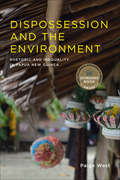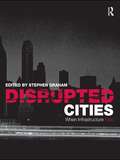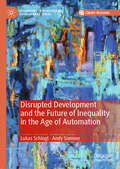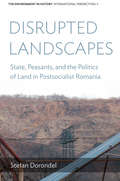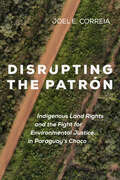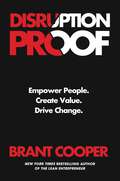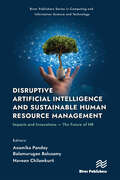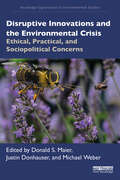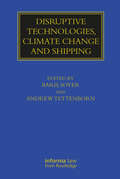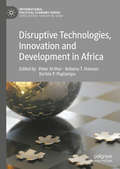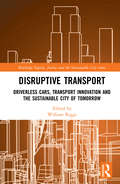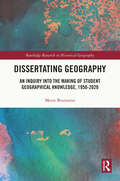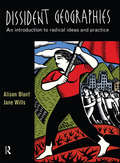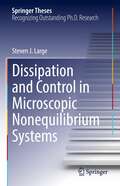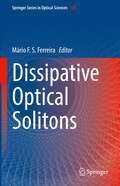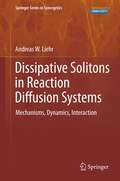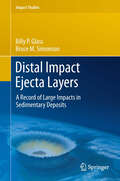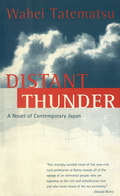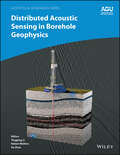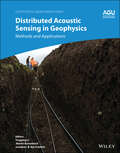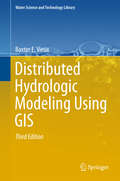- Table View
- List View
Disposition of High-level Waste and Spent Nuclear Fuel: The Continuing Societal and Technical Challenges
by National Research CouncilFocused attention by world leaders is needed to address the substantial challenges posed by disposal of spent nuclear fuel from reactors and high-level radioactive waste from processing such fuel. The biggest challenges in achieving safe and secure storage and permanent waste disposal are societal, although technical challenges remain. Disposition of radioactive wastes in a deep geological repository is a sound approach as long as it progresses through a stepwise decision-making process that takes advantage of technical advances, public participation, and international cooperation. Written for concerned citizens as well as policymakers, this book was sponsored by the U.S. Department of Energy, U.S. Nuclear Regulatory Commission, and waste management organizations in eight other countries.
Dispossession and the Environment: Rhetoric and Inequality in Papua New Guinea (Leonard Hastings Schoff Lectures)
by Paige WestWhen journalists, developers, surf tourists, and conservation NGOs cast Papua New Guineans as living in a prior nature and prior culture, they devalue their knowledge and practice, facilitating their dispossession. Paige West's searing study reveals how a range of actors produce and reinforce inequalities in today's globalized world. She shows how racist rhetorics of representation underlie all uneven patterns of development and seeks a more robust understanding of the ideological work that capital requires for constant regeneration.
Disrupted Cities: When Infrastructure Fails
by Stephen GrahamBringing together leading researchers from geography, political science, sociology, public policy and technology studies, Disrupted Cities exposes the politics of well-known disruptions such as devastation of New Orleans in 2005, the global SARS outbreak in 2002-3, and the great power collapse in the North Eastern US in 2003. But the book also excavates the politics of more hidden disruptions: the clogging of city sewers with fat; the day-to-day infrastructural collapses which dominate urban life in much of the global south; the deliberate devastation of urban infrastructure by state militaries; and the ways in which alleged threats of infrastructural disruption have been used to radically reorganize cities as part of the ‘war on terror’. Accessible, topical and state-of-the art, Disrupted Cities will be required reading for anyone interested in the intersections of technology, security and urban life as we plunge headlong into this quintessentially urban century. The book’s blend of cutting-edge theory with visceral events means that it will be particularly useful for illuminating urban courses within geography, sociology, planning, anthropology, political science, public policy, architecture and technology studies.
Disrupted Development and the Future of Inequality in the Age of Automation (Rethinking International Development series)
by Andy Sumner Lukas SchloglThis open access book examines the future of inequality, work and wages in the age of automation with a focus on developing countries. The authors argue that the rise of a global ‘robot reserve army’ has profound effects on labor markets and economic development, but, rather than causing mass unemployment, new technologies are more likely to lead to stagnant wages and premature deindustrialization. The book illuminates the debate on the impact of automation upon economic development, in particular issues of poverty, inequality and work. It highlights public policy responses and strategies–ranging from containment to coping mechanisms—to confront the effects of automation.
Disrupted Landscapes: State, Peasants and the Politics of Land in Postsocialist Romania
by Stefan DorondelThe fall of the Soviet Union was a transformative event for the national political economies of Eastern Europe, leading not only to new regimes of ownership and development but to dramatic changes in the natural world itself. This painstakingly researched volume focuses on the emblematic case of postsocialist Romania, in which the transition from collectivization to privatization profoundly reshaped the nation's forests, farmlands, and rivers. From bureaucrats abetting illegal deforestation to peasants opposing government agricultural policies, it reveals the social and political mechanisms by which neoliberalism was introduced into the Romanian landscape.
Disrupting the Patrón: Indigenous Land Rights and the Fight for Environmental Justice in Paraguay's Chaco
by Joel E. CorreiaA free ebook version of this title is available through Luminos, University of California Press’s Open Access publishing program. Visit www.luminosoa.org to learn more. In Paraguay’s Chaco region, cattle ranching drives some of the world’s fastest deforestation and most extreme inequality in land tenure, with grave impacts on Indigenous well‑being. Disrupting the Patrón traces Enxet and Sanapaná struggles to reclaim their ancestral lands from the cattle ranches where they labored as peons—a decades-long resistance that led to the Inter‑American Court of Human Rights and back to the frontlines of Paraguay’s ranching frontier. The Indigenous communities at the heart of this story employ a dialectics of disruption by working with and against the law to unsettle enduring racial geographies and rebuild territorial relations, albeit with uncertain outcomes. Joel E. Correia shows that Enxet and Sanapaná peoples enact environmental justice otherwise: moving beyond juridical solutions to harm by maintaining collective lifeways and resistance amid radical social-ecological change. Correia’s ethnography advances debates about environmental racism, ethics of engaged research, and Indigenous resurgence on Latin America’s settler frontiers.
Disruption Proof: Empower People, Create Value, Drive Change
by Brant CooperCEO and founder of Moves the Needle and New York Times bestselling author of The Lean Entrepreneur Brant Cooper teaches leaders how to ensure their organizations are resilient, agile, and dynamic enough to endure long-term, weathering the storms of disruption and uncertainty. One thing in life is certain: change is constant. Thanks to the rapid pace of technological innovation in the digital age—and further accelerated by the global COVID-19 pandemic—massive structural change is happening on a greater scale than ever before. Faced with unprecedented complexity and uncertainty, most business leaders struggle to see the way forward. Company organization, systems, and management are still largely based on what was most effective in the Industrial Age. Disruption Proof offers a new approach that addresses our current reality. Through powerful case studies of notable corporations like Intuit, 3M, Cargill, and more, Cooper demonstrates how, with the right mindset and practical strategies, companies that focus on creating value for customers can thrive in the 21st century. Disruption Proof provides readers with detailed methods for progressing through four stages of implementation to embrace a new way of working company-wide, including how to: develop an understanding of customers and colleagues that lead to insights (empathy)run tests to challenge assumptions (exploration)leverage data and insights to breakthrough biases (evidence)balance operational execution with learning (equilibrium)manage behavior to match corporate values (ethics) By adopting these 5Es, company leaders can empower employees to become creative problem solvers, ensuring their company&’s ability to navigate moments of crisis and find transformative opportunities. Cooper explains how reimagining work at every level is the key to organic and sustainable growth, and guides leaders to create lasting value in the world. With Cooper's action-oriented advice and tools, anyone can help steer their company towards durable success.
Disruptive Artificial Intelligence and Sustainable Human Resource Management: Impacts and Innovations -The Future of HR (River Publishers Series in Computing and Information Science and Technology)
by Naveen Chilamkurti Balamurugan Balusamy Anamika PandeyIt is well-established that every organization is founded with a specific purpose and goals. Virtually all business organizations obtain measurements and metrics dealing with outcomes and results. However, what is reflected on the balance sheet does not necessarily show the actual worth of the organizations and ensure their survival and sustainability. Thus, the question arises, what exactly makes the organizations sustainable and thriving in an ever-changing environment? There are several examples of companies like Faber-Castell, Bank of Ireland, Chivas, DuPont and many more which have been able to sustain and survive over more than 200 years and still have a successful existence in the present era. Thus, it is important for the organization to pay equal attention to its three bottom lines, i.e., people, profit and planet for its sustainability, which not only meet the needs of the present generation but should have a futuristic approach as well. In the present era, organizations are adopting a new normal working dynamic and coping with the post-pandemic situations to sustain themselves in the business environment. Technology plays a significant role in this new working dynamic, and cutting-edge technologies like machine learning, artificial intelligence, blockchain,ChatGPT, Internet of Things, and much more effectively facilitate human functioning at work. The book aims to contribute to understanding and developing sustainable human resource management processes and practices aligned with recent technologies. It highlights the interconnection among the three bottom-line sustainable approaches for the growth and development of the organization. Topics discussed in this book include: • Disruptive Technologies and HR Sustainability • Convergence of Innovative Technologies, HR and Organizational Growth • Triple bottom-line Sustainability for HRM • Business-oriented Talent analytics and HR Sustainability • Role of Leadership in sustainable HRM practices.
Disruptive Innovations and the Environmental Crisis: Ethical, Practical, and Sociopolitical Concerns (Routledge Explorations in Environmental Studies)
by Michael Weber Donald S. Maier Justin DonhauserThis book probes the ethical, practical, and sociopolitical implications of leveraging innovative and disruptive means to address the world’s various environmental crises.Packed with keen observations and analyses, the volume brings together research from seasoned scholars and rising stars to cast important new light on urgent issues engendered by humankind’s disruption of environments, such as climate change and biodiversity loss. It tackles the question of exactly what has been disrupted in the world—environmentally, economically, socially, and politically. It also examines an assortment of innovative interventions that aim to address disruptions and explores the question of what further disruptions may lurk behind assorted innovative interventions intended to address already existing disruptions. Chapters wrestle with the social, ethical, and ecological implications of disruptions, both pre-existing and those brought about by interventions, connected with deploying artificial gene drives, substituting robotic pollinators for living ones, synthesizing organisms to replace ones lost, installing economic regimes that work well for both citizens and the environment, making science subservient to non-scientific commitments, involving citizens in environmentally consequential decisions, choosing scientific and technological projects that most promise immediate practical payoff, and ensuring that respect for human rights is part and parcel of any technology-infused project. These discussions draw on a rich mix of science, philosophy of science, political theory, economics, sociology, network theory, ethics, and theories of justice and human rights.This book will be of great interest to students and scholars of environmental science, environmental decision-making, ecology, climate change, environmental philosophy, and the philosophy of science.
Disruptive Technologies, Climate Change and Shipping (Maritime and Transport Law Library)
by Simon Baughen Andrew Tettenborn Bariş SoyerThis book analyses the impact of two vital and contemporary developments on shipping law and practice: disruptive technologies and climate change. It considers the impact of these new technologies, honing in on likely emerging issues and unresolved questions, especially about existing and potential private law liabilities and concentrates, from the point of view of English, EU and international law, on the legal implications of climate change and associated environmental risks in the shipping sector. Written by a contributor team drawn from the most experienced and knowledgeable academics and practitioners in shipping law, this treatment of these growing areas of practice will be of great use to lawyers and administrators across the world.
Disruptive Technologies, Innovation and Development in Africa (International Political Economy Series)
by Kobena T. Hanson Korbla P. Puplampu Peter ArthurThis book examines how disruptive technologies and innovation underpin the attainment of a broader development agenda in Africa. Contributors show how distinctive forms of technological innovation can impact critical development processes. For example, disruptive technologies can deepen the ongoing democratic and governance waves in Africa, specifically in the area of contested elections. Similarly, innovations in agriculture, the environment and energy promote changes in value chain agriculture, and the use of sensors to manage e-waste and sustainable energy conservation are also transforming established practices. Furthermore, the role of disruptive technologies and innovation in education, health, financial services and the nature of paid work cannot be ignored. Individually and collectively, the authors discuss and highlight the mechanisms and initiatives that can contribute to the realization of the development goals of African countries, especially in a period where disruptive technologies are rapidly changing how things are done. As a result, this book, which represents one of the most recent systematic efforts to bring together dialogue on disruptive technologies in Africa, will be of particular use and benefit to a wide and an eclectic audience.
Disruptive Transport: Driverless Cars, Transport Innovation and the Sustainable City of Tomorrow (Routledge Equity, Justice and the Sustainable City series)
by William RiggsWith the rise of shared and networked vehicles, autonomous vehicles, and other transportation technologies, technological change is outpacing urban planning and policy. Whether urban planners and policy makers like it or not, these transformations will in turn result in profound changes to streets, land use, and cities. But smarter transportation may not necessarily translate into greater sustainability or equity. There are clear opportunities to shape advances in transportation, and to harness them to reshape cities and improve the socio-economic health of cities and residents. There are opportunities to reduce collisions and improve access to healthcare for those who need it most—particularly high-cost, high-need individuals at the younger and older ends of the age spectrum. There is also potential to connect individuals to jobs and change the way cities organize space and optimize trips. To date, very little discussion has centered around the job and social implications of this technology. Further, policy dialogue on future transport has lagged—particularly in the arenas of sustainability and social justice. Little work has been done on decision-making in this high uncertainty environment–a deficiency that is concerning given that land use and transportation actions have long and lagging timelines. This is one of the first books to explore the impact that emerging transport technology is having on cities and their residents, and how policy is needed to shape the cities that we want to have in the future. The book contains a selection of contributions based on the most advanced empirical research, and case studies for how future transport can be harnessed to improve urban sustainability and justice.
Dissertating Geography: An Inquiry into the Making of Student Geographical Knowledge, 1950-2020 (Routledge Research in Historical Geography)
by Mette BruinsmaThis book examines the history of geography (1950-2020) from a bottom-up perspective. Disciplinary histories often emphasise the pronouncements of established academics, yet student-geographers make up the majority of the overall ‘geographical community’ at any one time. Exploring these efforts of geography students over the last seventy years places the known history of the discipline in a new perspective. A disciplinary history ‘from below’ recognises and acknowledges student dissertations and advances three core propositions: first, they are produced by an overlooked but nonetheless central grouping in the geographical community; second, the rich archival collection of dissertations specifically consulted here contains many excellent geographical knowledge productions that have remained barely read, until now; and third, there is a wish to encourage others to explore similar collections of student knowledge productions held elsewhere. This book will be an important resource for scholars and postgraduate students in Geography, Education and the History and Theory of Geography.
Dissident Geographies: An Introduction to Radical Ideas and Practice
by Jane Wills Alison BluntDissident Geographies is an accessible and lively exploration of radical perspectives in human geography. The perspectives examined in the book reveal and resist certain power relations that have constituted geographical knowledge. The book has two main aims. First, rather than reify 'the' geographical tradition, Dissident Geographies introduces a number of geographical traditions that challenge and destabilize what counts as geographical knowledge. Second, the book shows how the production of geographical knowledge is tied to politics and struggles outside as well as within the academy. In each chapter, case studies illustrate the spatiality of political practice and the politics of geographical thought. In this way Dissident Geographies reveals the connections between power, politics and geographical knowledge.
Dissipation and Control in Microscopic Nonequilibrium Systems (Springer Theses)
by Steven J. LargeThis thesis establishes a multifaceted extension of the deterministic control framework that has been a workhorse of nonequilibrium statistical mechanics, to stochastic, discrete, and autonomous control mechanisms. This facilitates the application of ideas from stochastic thermodynamics to the understanding of molecular machines in nanotechnology and in living things. It also gives a scale on which to evaluate the nonequilibrium energetic efficiency of molecular machines, guidelines for designing effective synthetic machines, and a perspective on the engineering principles that govern efficient microscopic energy transduction far from equilibrium. The thesis also documents the author’s design, analysis, and interpretation of the first experimental demonstration of the utility of this generally applicable method for designing energetically-efficient control in biomolecules. Protocols designed using this framework systematically reduced dissipation, when compared to naive protocols, in DNA hairpins across a wide range of experimental unfolding speeds and between sequences with wildly different physical characteristics.
Dissipative Optical Solitons (Springer Series in Optical Sciences #238)
by Mário F. S. FerreiraThis book introduces the basic concept of a dissipative soliton, before going to explore recent theoretical and experimental results for various classes of dissipative optical solitons, high-energy dissipative solitons and their applications, and mode-locked fiber lasers.A soliton is a concept which describes various physical phenomena ranging from solitary waves forming on water to ultrashort optical pulses propagating in an optical fiber. While solitons are usually attributed to integrability, in recent years the notion of a soliton has been extended to various systems which are not necessarily integrable. Until now, the main emphasis has been given to well-known conservative soliton systems, but new avenues of inquiry were opened when physicists realized that solitary waves did indeed exist in a wide range of non-integrable and non-conservative systems leading to the concept of so-called dissipative optical solitons. Dissipative optical solitons have many unique properties which differ from those of their conservative counterparts. For example, except for very few cases, they form zero-parameter families and their properties are completely determined by the external parameters of the optical system. They can exist indefinitely in time, as long as these parameters stay constant. These features of dissipative solitons are highly desirable for several applications, such as in-line regeneration of optical data streams and generation of stable trains of laser pulses by mode-locked cavities.
Dissipative Solitons in Reaction Diffusion Systems
by Andreas W. LiehrWhy writing a book about a specialized task of the large topic of complex systems? And who will read it? The answer is simple: The fascination for a didactically valuable point of view, the elegance of a closed concept and the lack of a comprehensive disquisition. The fascinating part is that field equations can have localized solutions exhibiting the typical characteristics of particles. Regarding the field equations this book focuses on, the field phenomenon of localized solutions can be described in the context of a particle formalism, which leads to a set of ordinary differential equations covering the time evolution of the position and the velocity of each particle. Moreover, starting from these particle dynamics and making the transition to many body systems, one considers typical phenomena of many body systems as shock waves and phase transitions, which themselves can be described as field phenomena. Such transitions between different level of modelling are well known from conservative systems, where localized solutions of quantum field theory lead to the mechanisms of elementary particle interaction and from this to field equations describing the properties of matter. However, in dissipative systems such transitions have not been considered yet, which is adjusted by the presented book. The elegance of a closed concept starts with the observation of self-organized current filaments in a semiconductor gas discharge system. These filaments move on random paths and exhibit certain particle features like scattering or the formation of bound states. Neither the reasons for the propagation of the filaments nor the laws of the interaction between the filaments can be registered by direct observations. Therefore a model is established, which is phenomenological in the first instance due to the complexity of the experimental system. This model allows to understand the existence of localized structures, their mechanisms of movement, and their interaction, at least, on a qualitative level. But this model is also the starting point for developing a data analysis method that enables the detection of movement and interaction mechanisms of the investigated localized solutions. The topic is rounded of by applying the data analysis to real experimental data and comparing the experimental observations to the predictions of the model. A comprehensive publication covering the interesting topic of localized solutions in reaction diffusion systems in its width and its relation to the well known phenomena of spirals and patterns does not yet exist, and this is the third reason for writing this book. Although the book focuses on a specific experimental system the model equations are as simple as possible so that the discussed methods should be adaptable to a large class of systems showing particle-like structures. Therefore, this book should attract not only the experienced scientist, who is interested in self-organization phenomena, but also the student, who would like to understand the investigation of a complex system on the basis of a continuous description.
Dissolved Air Flotation: Equipment, Best Practice and Applications (Springer Water)
by Roumen KaltchevThis book provides an overview of the dissolved air flotation clarification technology. It brings together the three strands of knowledge and experience accumulated in this field - the analysis of the main phenomena involved and the interactions between them, the equipment for its implementation and its main applications in water treatment. The author draws attention to the design and operation of the different equipment used in practice, their advantages, and disadvantages in the different fields of application of this technology.The book is intended for:•Engineers and technicians working on the design of equipment and its integration into the overall water treatment plant as well as in the operation of flotation plants.•Consultants and engineering offices, hoping that it will help them to make the most appropriate choices regarding the applications of this process, as well as in the equipment selections.•Wastewater treatment plants operators, in the hope that it will help them to optimise the operation of their plants and improve their understanding and analysis of some problems they may encounter.•Purchasers and contractors, who have to make sometime difficult choices for reducing costs and, at the same time, ensure and guarantee the long-term performance and reliability of the plant.The book is oriented towards the practical side of implementing the technology. It contains a lot of information about the equipment (much more than in all other available publications on the same subject) as well as practical comments and recommendations that are very rarely found in this kind of book, written mostly by researchers. It will appeal to specialists who are comfortable with water chemistry, but it may also be of interest to water professionals who are more interested in the equipment, design and operation of water treatment plants.
Distal Impact Ejecta Layers
by Billy P. Glass Bruce M. SimonsonImpact cratering is an important geological process on all solid planetary bodies, and, in the case of Earth, may have had major climatic and biological effects. Most terrestrial impact craters have been erased or modified beyond recognition. However, major impacts throw ejecta over large areas of the Earth's surface. Recognition of these impact ejecta layers can help fill in the gaps in the terrestrial cratering record and at the same time provide direct correlation between major impacts and other geological events, such as climatic changes and mass extinctions. This book provides the first summary of known distal impact ejecta layers
Distance, Equity and Older People’s Experiences in the Nordic Periphery: Centering the Local (Routledge Research in Polar Regions)
by Shahnaj Begum Päivi Naskali Joan R. Harbison Minna ZechnerThis book demonstrates how the largely neglected and multifaceted concept of distance can be used as a primary lens to expand and enrich our understandings of what older people say about their lives, needs and wishes in diverse surroundings in the Northern periphery and beyond. It asks how physical, social and emotional distances shape older people’s everyday lives and practices. Contributions from leading experts provides interdisciplinary investigations into the experiences and stories of older people in the Northern periphery. These insights demonstrate the utility of the concept, distance, when reflecting on the central aspects of contemporary ageing societies. The book explores key themes such as care, age politics, technology, intergenerational relations and migration, providing perspectives that are applicable across a variety of international geographical contexts. This innovative book offers a valuable theoretical and methodological contribution with critical new perspectives on ageing in relation to distances. It will be of interest to students and scholars interested in sociology, human geography, health and social care, ageing and gerontological studies, gender studies and Arctic studies.
Distance, Equity and Older People’s Experiences in the Nordic Periphery: Centering the Local (Routledge Research in Polar Regions)
by Shahnaj Begum Päivi Naskali Joan R. Harbison Minna ZechnerThis book demonstrates how the largely neglected and multifaceted concept of distance can be used as a primary lens to expand and enrich our understandings of what older people say about their lives, needs and wishes in diverse surroundings in the Northern periphery and beyond. It asks how physical, social and emotional distances shape older people’s everyday lives and practices. Contributions from leading experts provides interdisciplinary investigations into the experiences and stories of older people in the Northern periphery. These insights demonstrate the utility of the concept, distance, when reflecting on the central aspects of contemporary ageing societies. The book explores key themes such as care, age politics, technology, intergenerational relations and migration, providing perspectives that are applicable across a variety of international geographical contexts. This innovative book offers a valuable theoretical and methodological contribution with critical new perspectives on ageing in relation to distances. It will be of interest to students and scholars interested in sociology, human geography, health and social care, ageing and gerontological studies, gender studies and Arctic studies.
Distant Thunder
by Wahei TatematsuWinner of the Noma Prize for New WritersSet in rural Japan at the height of the bubble economy, Distant Thunder tells of a farming village gradually effaced by urbanization, corruption, and greed. After Matsuzo Wada has sold off the family's lands and left his wife for another woman, his son Mitsuo is determined to support himself and his mother in the traditional manner, farming. All that remains of his ancestors' lands is a hothouse, in which he grows tomatoes to sell to the housewives from the nearby apartment complex, built on a former rice field. When his childhood friend, Koji, becomes entangled in an adulterous love affair which ultimately destroys him and those around him, Mitsuo begins to see how the town's hedonistic excesses are laying to waste not only the landscape, but also the communal and familial bonds and the values that once sustained them all.Translated from the Japanese by Lawrence J. Howell and Hikaru Morimoto.
Distributed Acoustic Sensing in Borehole Geophysics (Geophysical Monograph Series #288)
by Yingping Li Robert Mellors Ge ZhanDistributed Acoustic Sensing in Borehole Geophysics Borehole geophysics involves measuring, imaging, and monitoring subsurface structures and activities by putting instruments into wellbores. Distributed acoustic sensing (DAS) technology is emerging as an effective and reliable tool in borehole geophysics because fiber-optic cables deployed at depth can produce high-quality data and images, even in harsh high-temperature and high-pressure environments. Distributed Acoustic Sensing in Borehole Geophysics is a comprehensive handbook on cutting-edge advances in borehole DAS technologies and their practical applications across geophysics. Volume highlights include: Summary of the evolution of DAS technologies and their primary applicationsNew developments in borehole DAS instrumentation and modelingExamples of DAS data acquisition and processing in different contexts Variety of imaging methods and techniques for integration of images with other data Applications of borehole DAS systems, including monitoring earthquakes and hydraulic fracturing operationsCase studies of borehole DAS projects at diverse sites around the world, ranging from glaciers to geothermal fields The American Geophysical Union promotes discovery in Earth and space science for the benefit of humanity. Its publications disseminate scientific knowledge and provide resources for researchers, students, and professionals.
Distributed Acoustic Sensing in Geophysics: Methods and Applications (Geophysical Monograph Series #268)
by Yingping Li Martin Karrenbach Jonathan B. Ajo-FranklinDistributed Acoustic Sensing in Geophysics Distributed Acoustic Sensing in Geophysics Methods and Applications Distributed Acoustic Sensing (DAS) is a technology that records sound and vibration signals along a fiber optic cable. Its advantages of high resolution, continuous, and real-time measurements mean that DAS systems have been rapidly adopted for a range of applications, including hazard mitigation, energy industries, geohydrology, environmental monitoring, and civil engineering. Distributed Acoustic Sensing in Geophysics: Methods and Applications presents experiences from both industry and academia on using DAS in a range of geophysical applications. Volume highlights include: DAS concepts, principles, and measurements Comprehensive review of the historical development of DAS and related technologies DAS applications in hydrocarbon, geothermal, and mining industries DAS applications in seismology DAS applications in environmental and shallow geophysics The American Geophysical Union promotes discovery in Earth and space science for the benefit of humanity. Its publications disseminate scientific knowledge and provide resources for researchers, students, and professionals.
Distributed Hydrologic Modeling Using GIS
by Baxter E. VieuxThis book presents a unified approach for modeling hydrologic processes distributed in space and time using geographic information systems (GIS). This Third Edition focuses on the principles of implementing a distributed model using geospatial data to simulate hydrologic processes in urban, rural and peri-urban watersheds. The author describes fully distributed representations of hydrologic processes, where physics is the basis for modeling, and geospatial data forms the cornerstone of parameter and process representation. A physics-based approach involves conservation laws that govern the movement of water, ranging from precipitation over a river basin to flow in a river. Global geospatial data have become readily available in GIS format, and a modeling approach that can utilize this data for hydrology offers numerous possibilities. GIS data formats, spatial interpolation and resolution have important effects on the hydrologic simulation of the major hydrologic components of a watershed, and the book provides examples illustrating how to represent a watershed with spatially distributed data along with the many pitfalls inherent in such an undertaking. Since the First and Second Editions, software development and applications have created a richer set of examples, and a deeper understanding of how to perform distributed hydrologic analysis and prediction. This Third Edition describes the development of geospatial data for use in Vflo(r) physics-based distributed modeling.

